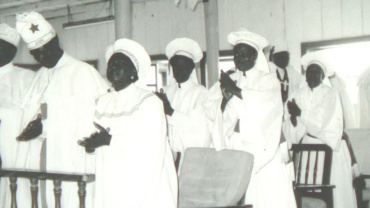When the people of Ayetoro tell the story of their beginnings, the name of Oba Ethiopia O. Peter always comes first. Known as the Ogeloyinbo, or “King of the White Robe,” he was the founding spiritual leader of the Happy City — a man whose vision and faith shaped a community that dared to live differently.
Born into the Ilaje region of coastal Ondo, Ethiopia Peter was drawn early to the Holy Apostles’ movement, a fellowship dedicated to living a life of holiness, equality, and service. In 1947, when members of the Apostles broke away to establish a new settlement by the sea, it was he who guided their steps. His authority did not rest on wealth or force, but on spiritual conviction and the respect he commanded through prayer, discipline, and wisdom.
Archival photographs show him in flowing white garments, staff in hand, surrounded by Apostles in solemn assembly. His presence was both humble and commanding, a reminder that leadership in Ayetoro was not about power but about service. Oral testimonies recall that when disputes arose, Ethiopia Peter’s words carried the weight of scripture. His counsel was sought not only for matters of faith but also for governance, for in Ayetoro there was no division between the sacred and the civic.
As the first Ogeloyinbo, he oversaw the structures that gave Ayetoro its character: the building of canals and bridges, the establishment of the community hall, and the rules that governed daily life. But more than anything, he was remembered for the way he kept the Apostles united. In times of scarcity, he reminded them to share. When persecution came from outsiders who doubted or opposed their ways, he urged them to stand firm. His leadership gave the young community both spiritual grounding and moral courage.
Under his guidance, worship became the heartbeat of the settlement. The image of worshippers in spotless white robes, singing hymns by the sea, was inseparable from Ethiopia Peter’s vision. He insisted that holiness was not confined to Sunday rituals but was to be lived daily — in fishing, in trade, in family life. To him, Ayetoro was not simply a town but a spiritual covenant, a place set apart to model a new way of living.

Visitors who came in the 1950s often remarked on the Ogeloyinbo’s dignity and calm authority. He welcomed outsiders with hospitality but remained firm in the Apostles’ principles. For many, his leadership explained why Ayetoro thrived in its early years, attracting admiration and earning the nickname “Small London.”
Though Ethiopia Peter has long passed, his legacy endures in the memory of Ayetoro’s people. His name is invoked in prayers, his staff of authority remembered as a symbol of righteous leadership, and his example continues to inspire younger generations. As one elder reflected: “He was more than a king. He was our conscience, our guide, and the one who showed us how to walk in white.”




